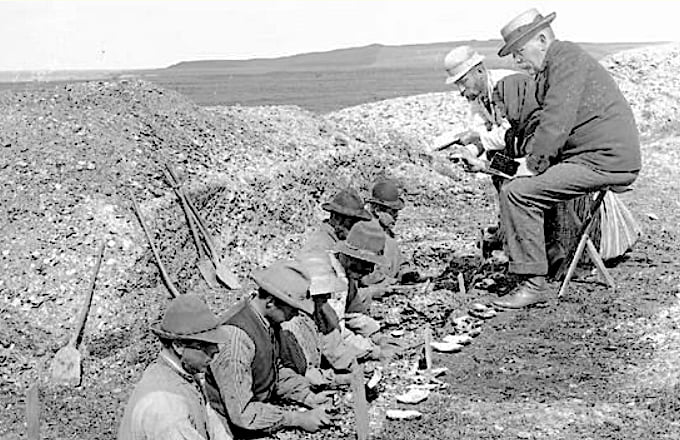The earliest kitchen middens archaeological record of herring eating and why no earlier herring bones have been found
ARCHAEOLOGY
Beginning in 1848, otherwise known as the Year of Revolutions, Danish archaeologists were the first to develop the excavation of kitchen middens. Early Neolithic Danes may not have been the first herring eaters, but they are the earliest to have left proof.
100m long, between 50m and 70m metres wide and 1-3m high, kitchen middens are the piled leftovers of meals. There were no neolithic binmen. At coastal sites, the archaeologists found shells (mussels, in particular) and fish bones, the commonest of which were herring, cod, flounder and eel.
Hooks of various design were discovered, but although no boats or nets survived, the abundance of herring bones – and the presence of other deep sea fish bones – points to them not being caught exclusively from the shore or with hooks. Some form of seine net has been suggested as the probable technology.
The Southern Scandinavian fish-eaters associated with the middens are referred to known as the Ertebølle Culture (after the Jutland village where the bones and shells were first discovered), often shortened to EBK.

The discovery places the earliest recorded herring fishery between 3,000 and 5,000 BC. EBK began to replace Kongemuse Culture (Kongemosekulturen) around 5,300 BC. After an expansion as far as what later became to smoked fish heaven of Rügen, at some point not long after 4,100 BC the EBKs were in turn replaced by Funnelbeaker Culture (TBK). The smart money, however, is probably still on the EBKs as the earliest recorded herring fishers.
Herring remains have been found in more recent kitchen middens throughout Northern Europe and the Atlantic and Pacific coasts of North America, but records suffer from the fact that the herring’s fine bones do not survive as well as those of some other fish, particularly in acidic, peaty soil.
Höglund
Herring archaeology took a major step forward in the 1950s, when the Swedish marine biologist Hans Höglund dug up several waste pits of the Bohüslan herring boom from 1752 to 1810. Why were there herring waste pits? Because Bohüslan booms come roughly every hundred years: irregular gluts create problems, but at the same time the late C18th Swedish authorities wanted the boom to continue and thought the shoals might take offence at the smell of excess catches thrown overboard.
The reason Höglund exhumed the previously unwanted herring dead was that he wanted to settle the question of which herrings were responsible for the booms. The assumption had been that they were Norwegian spring spawners that had moved south, but through examination of the buried herrings he established they were a southern North Sea population that had moved east.
Höglund’s research was published in the 1970s. In the context of archaeology’s previous record on herring-associated projects, what has emerged since is revolutionising herring history.
The Zooarchaeologists
Höglund’s herring bones were at most a couple of hundred years old: he could easily count the vertebrae and examine the otoliths that could tell him where the herrings came from. Going back to kitchen middens, a new generation of archaeologists began ever more careful soil sifting. And finer meshes find finer bones.
Analysis of the ancient DNA of fish bones reveals which specific fish populations they come from. Analysis of human remains suggests the proportion of marine and/or freshwater fish in their diet. All of this builds a picture of trade. It’s maybe not surprising that this has been able to attract European Union funding.
There has been a sea-change in herring archaeology over the past 20 years. Did the Romans eat herring? Analysis of fermented fish sauce amphoras in Belgium says yes they did. And sprats. Did the Dutch develop new gutting techniques in the C14th? No, apparently they didn’t – the cut marks on herring bones from the Scania fishery reveal the same techniques were used in the C12th and C13th.
Zooarchaeology is also transforming herring-based cultural understanding in the Pacific North West of the United States and Canada, where the revealed, dietary proportions of traditional herring consumption play into the struggle for sustainable fishery rights.
Exciting times and no mistake!
